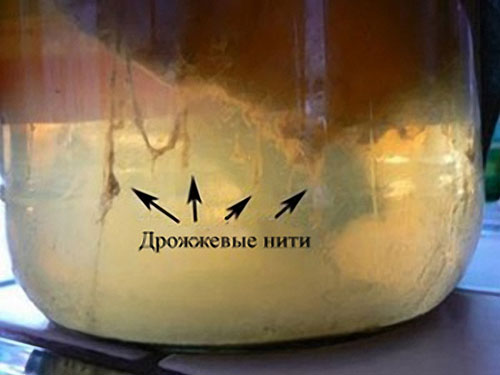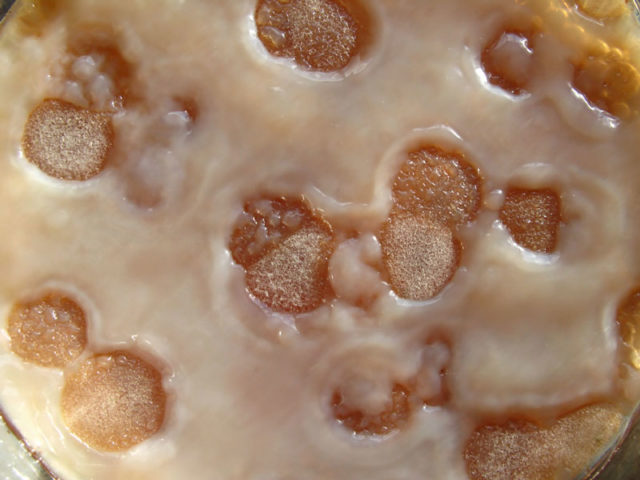Content
It is not difficult to understand that the kombucha has gone bad in appearance. However, in order to prevent him from reaching such a state, you need to know the first signs. If they occur, timely action will help heal kombucha.
Can kombucha go bad
Subject to the rules of cultivation and sanitation, tea jellyfish rarely disappears. Sometimes spider webs hanging from the jellyfish are mistaken for depravity. This is actually a normal kombucha growth process. The web is formed by yeast threads, due to which fermentation and fermentation occurs.
If the drink was poorly looked after, the water was changed at the wrong time, sanitary rules were ignored, it is capable of disappearing. Sometimes this happens not through human fault, but from harmful insects. It depends on the degree of spoilage whether it is possible to reanimate the kombucha at home or whether it is already useless to do it.
Most often, tea jellyfish deteriorates due to human fault. In the process of careless care, cuts and tears appear. The body of the medusomycete is weakened. He is more vulnerable to pathogens of various diseases.
If the sugar or the infusion is improperly filled, the particles will settle on the kombucha's body. Burns occur in the form of brown or brown patches. To resuscitate the jellyfish, they urgently need to be removed.
Failure to comply with the temperature regime or frequent exposure to sunlight contributes to the development of algae. Tea jellyfish will disappear if not rinsed in time under running water.
Mold is the kombucha's worst enemy, and it can lead to destruction. It is formed when the environment is not acidic enough. Mold affects only the part of the tea jellyfish that is periodically in contact with air.
There are many other reasons that kombucha can disappear. You need to know them in order to prevent danger in time.
In the video, the cultivation of jellyfish:
How to understand that kombucha is dying
To easily determine the spoilage of a tea jellyfish, you need to know how it looks healthy. When any deviations from the norms appear, it already indicates the beginning of a negative process.

Healthy kombuchi resemble jelly pancakes
A healthy tea jellyfish has a uniform body that feels like elastic jelly to the touch. It is often shaped like a pancake. Body color is similarly uniform. It is milky or beige in color. Sometimes dark and light shades appear.
First of all, the change in color makes it clear that the kombucha is gone or is just starting to deteriorate. The problem is indicated by pronounced symptoms in the form of mold, holes in the body, cloudy liquid and a change in taste.
Important! If you suspect that the mushroom is spoiled, you can not drink the drink.
Kombucha damage
Mechanical damage to kombucha is not a disease, but it will lead to it if resuscitation is not done in a timely manner. Most often, the body of a jellyfish suffers from tears, punctures, cuts.
Why do holes appear in kombucha
A body with holes cannot be called terminally ill, but it cannot be classified as a healthy mushroom either.Punctures are often obtained if the jellyfish is carelessly removed from the jar with a metal utensil. Even nails can cause cuts on the body. During care, it is advisable to wear medical gloves if you have a long manicure on your hands.
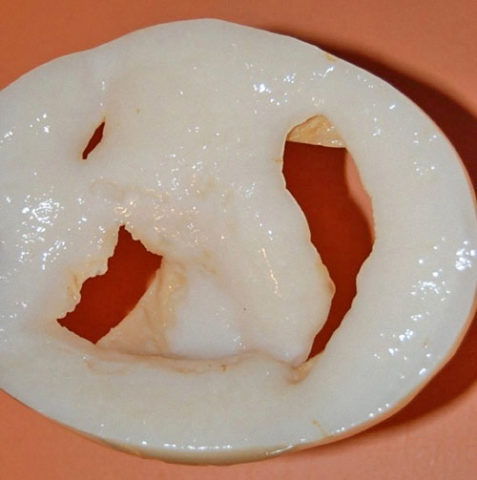
Holes are common damage to jellyfish
Strong cuts, tears, large holes occur when a jar is broken. The kombuchu is damaged by glass shards. A trifle can even get stuck and stay in the body.
What to do if a kombucha breaks
Mechanical damage to kombucha is less dangerous than disease. To quickly revive kombucha, it is placed in freshly made sweet tea. The solution should cover the body lightly. The fungus is not disturbed for several days until recovery occurs. Cambucha has good regenerating properties. The plate will heal on its own, grow, and then the drink can be consumed.
Kombucha disease
Kombucha disease is much more dangerous than normal injury. If the pathogens are not eliminated in a timely manner, it will not be possible to reanimate the jellyfish. The kombuchevod should know the common diseases of kombucha and their treatment, otherwise a spoiled drink can harm your health.
Algae damage
If the technological process of growing tea jellyfish is violated, algae appear in the jar. They are usually blue or green in color. Algae spreads along the wall of the can or simply floats in the drink. The liquid becomes cloudy.
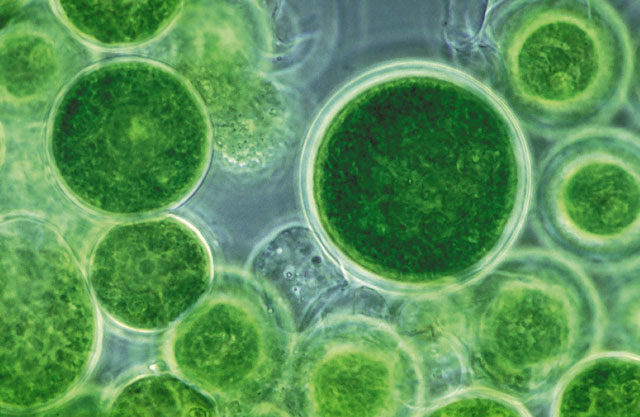
If you violate the rules of care, green and blue algae grow in a can with a drink.
Algae overgrowth is caused by one of three factors:
- A jar of tea jellyfish was left on a window or table, where direct sunlight falls during the day.
- The kombucha was left in a cool place and the drink cooled down. It is important to constantly maintain the temperature of the liquid above 18aboutFROM.
- Algae are formed when the acidic kombucha is not enough, the nutrient medium is slightly alkaline with a pH of 7.5-8.5.
Algae will not do much harm to human health. However, it is better not to drink such a drink. To prevent the appearance of algae, you need to follow the rules for caring for the mushroom.
Insects
Flies, midges, ants and other insects carry the infection into the drink can. They are attracted by the nutrients created by the fermentation of sugar with yeast. Insects get inside the jar, lay eggs on the body of the fungus. After a day, they turn into worms. The larvae crawl along the walls of the can, fall into the drink. It is categorically impossible to drink such a tea infusion. To keep insects out of the jellyfish, the neck of the jar should always be covered with a breathable cloth or napkin.
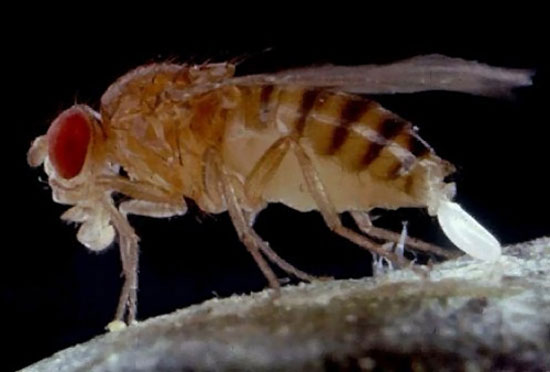
Kombuche diseases are often carried by insects
Mold fungi
Tea jellyfish produces secondary metabolites. They prevent mold from growing and spreading. However, if the technology of growing the mushroom is violated, the level of danger increases. Mold usually begins to grow on young, low-layer jellyfish, when no starter was added during their setting. The mushrooms do not have time to develop acidity. In a slightly alkaline environment, mold spreads quickly.
Mold never appears between layers of tea jellyfish. It grows on the surface of the kombucha in contact with air. Mold is a dangerous, tenacious and insidious enemy.You cannot drink a moldy drink. If the mold is blue or black, discard the affected fungus. When it is decided to cure the kombucha, if it is sick, the whole drink is poured out. The upper layers of the jellyfish are removed, washed with water. Cleaned kombucha is placed in a sterilized jar, poured with fresh solution with the addition of 1 tbsp. l. fruit vinegar.
Burn
To make the tea jellyfish live, sugar is periodically added to the drink. However, dry crystals cannot be poured into a jar with a mushroom. Sugar is deposited on the body of the kombucha. From a high concentration, foci are created that form an alkaline environment. Colonies of beneficial bacteria die, which is displayed on the body with brown or brown spots. These are the very burns. If you continue feeding in the same spirit, over time, the kombucha will die completely.
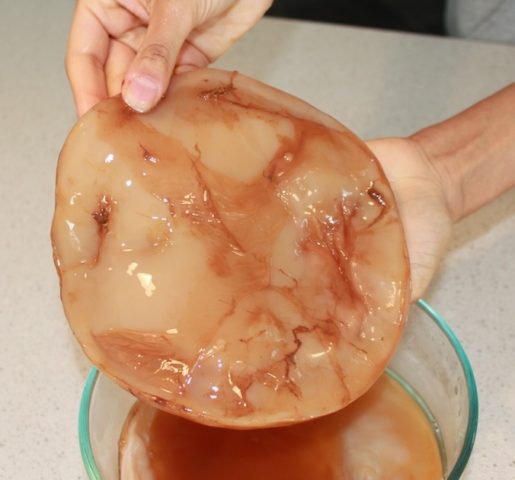
Kombucha burns are easily identified by brown or brown patches.
Sugar in its pure form is never poured into the jar. The solution is prepared in advance, and kombucha is already placed in it. If such a carelessness has already happened, the burnt area is removed from the jellyfish. In the future, they adhere to the rules for preparing a sweet solution.
How to revive kombucha
If the jellyfish can still be saved, the first step is to rinse it thoroughly with warm clean water. The thick kombucha is divided in layers. Each "pancake" is laid out in sterilized jars, where a ready-made solution of weak tea and sugar brewing is poured. The recovery will be evidenced by the appearance of a film on the surface of the kombucha matte shade. This is how the new kombucha is formed. If the old mushroom does not float up over time, but sank to the bottom, you can safely discard it. The young jellyfish continue to be fed. The drink can be drunk when the mushroom is fully restored.
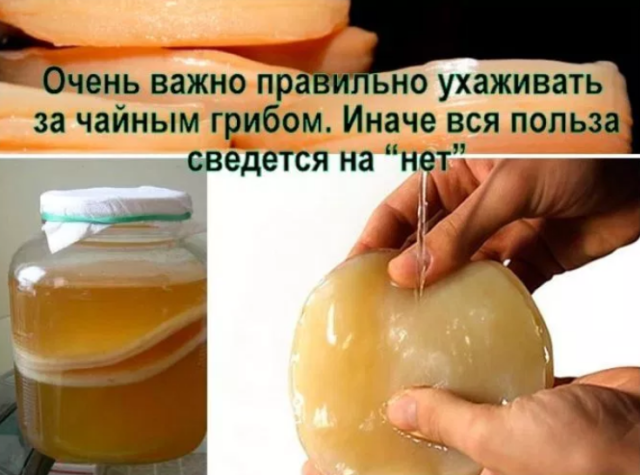
Most resuscitation techniques are based on rinsing the kombucha thoroughly with water.
How to tell if a kombucha is dead
Live mushrooms float in the drink. When they get sick, they sink to the bottom of the can. Medusa is urgently reanimated. After being placed in a new solution, the kombucha will lie on the bottom for a while until it regains its strength. If the mushroom does not want to float up, you will have to say goodbye to it. A symptom of 100% indicates the impossibility of further resuscitation.
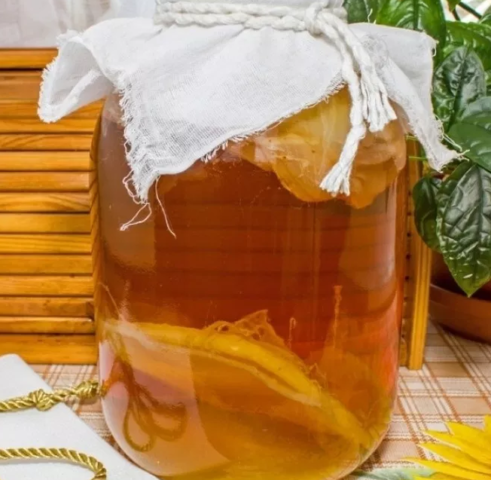
If, after resuscitation, the mushroom continues to lie at the bottom of the jar, then it can be considered completely lost.
A few tips to keep Kombucha from getting sick
A few tips will help prevent fungus diseases:
- For growing, I use sterilized cans with a volume of 2-3 liters. The neck is covered with a breathable fabric. Nylon or metal caps cannot be used.
- The solution is prepared from 1 liter of warm water and 100 g of sugar, and only after cooling to room temperature is poured into a jar.
- Always use two cans. A mushroom lives in one, and the other serves to drain the finished drink.
- It is optimal to keep kombucha in the shade at a temperature of about +25aboutC. Ready infusion is drained in winter after 5 days, in summer - after 4 days. The jellyfish is washed in the summer after 2 weeks, in the winter - every 4 weeks.
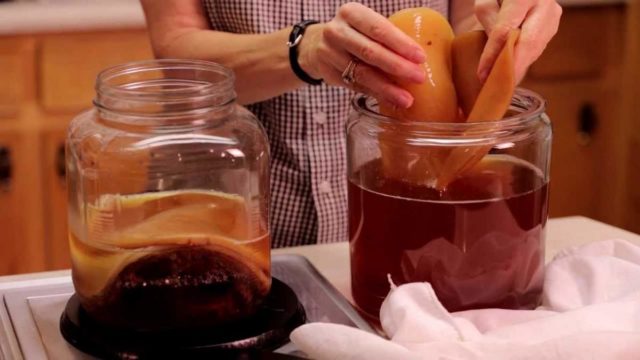
Proper care will prevent the development of kombuchi diseases
The mushroom should not be allowed to stand in the finished drink. From this, a brownish film of brown tint appears, indicating the beginning of the disappearance of kombucha.
Conclusion
It is not so difficult to understand that the kombucha has deteriorated due to the changed appearance. It is more difficult to revive it, and sometimes it is simply impossible if the care technology is violated.
